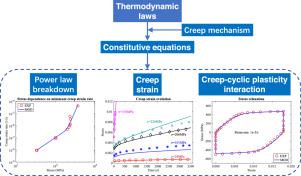International Journal of Mechanical Sciences ( IF 7.1 ) Pub Date : 2021-11-11 , DOI: 10.1016/j.ijmecsci.2021.106923 Li Meng 1, 2 , Wufan Chen 3, 4

|
Creep and cyclic plasticity are two common mechanical behaviors in engineering, and their interaction significantly affects the performance and degradation of corresponding components and structures, especially at high temperatures. How to build a physically based model for describing materials’ mechanical response under complex loading is still a challenge. This study proposes a thermodynamically based model for describing complex creep plasticity behaviors, such as cyclic plasticity and creep. Unlike existing models, the proposed model can describe time-dependent cyclic plasticity and clarify the contribution of various creep mechanisms. Starting from the fundamental thermodynamic laws, Helmholtz free energy and dissipation analysis considering different creep mechanisms are introduced. Then, constitutive equations are derived according to the physical hypothesis of normality of dissipation space. In the proposed model, plastic deformation is thought to depend on static plasticity and creep, which is further decomposed into three parts based on diffusion and dislocation activities, and the contribution of each creep mechanism is explicitly described. Finally, a series experimental data of Ti-6-4 is used to verify the utility of the proposed model. Satisfactory modeling results are obtained, including primary creep, steady creep, power-law breakdown, and creep cyclic plasticity interactions, confirming the validity of the proposed model.
中文翻译:

一种新的基于热力学的蠕变和循环塑性模型
蠕变和循环塑性是工程中两种常见的力学行为,它们的相互作用会显着影响相应部件和结构的性能和退化,尤其是在高温下。如何建立一个基于物理的模型来描述复杂载荷下材料的机械响应仍然是一个挑战。本研究提出了一种基于热力学的模型,用于描述复杂的蠕变塑性行为,例如循环塑性和蠕变。与现有模型不同,所提出的模型可以描述随时间变化的循环塑性并阐明各种蠕变机制的贡献。从基本热力学定律出发,介绍了考虑不同蠕变机制的亥姆霍兹自由能和耗散分析。然后,本构方程是根据耗散空间正态性的物理假设推导出来的。在所提出的模型中,塑性变形被认为取决于静态塑性和蠕变,根据扩散和位错活动将其进一步分解为三部分,并明确描述了每种蠕变机制的贡献。最后,使用 Ti-6-4 的一系列实验数据来验证所提出模型的实用性。获得了令人满意的建模结果,包括初级蠕变、稳态蠕变、幂律击穿和蠕变循环塑性相互作用,证实了所提出模型的有效性。根据扩散和位错活动将其进一步分解为三个部分,并明确描述了每种蠕变机制的贡献。最后,使用 Ti-6-4 的一系列实验数据来验证所提出模型的实用性。获得了令人满意的建模结果,包括初级蠕变、稳态蠕变、幂律击穿和蠕变循环塑性相互作用,证实了所提出模型的有效性。根据扩散和位错活动将其进一步分解为三个部分,并明确描述了每种蠕变机制的贡献。最后,使用 Ti-6-4 的一系列实验数据来验证所提出模型的实用性。获得了令人满意的建模结果,包括初级蠕变、稳态蠕变、幂律击穿和蠕变循环塑性相互作用,证实了所提出模型的有效性。











































 京公网安备 11010802027423号
京公网安备 11010802027423号